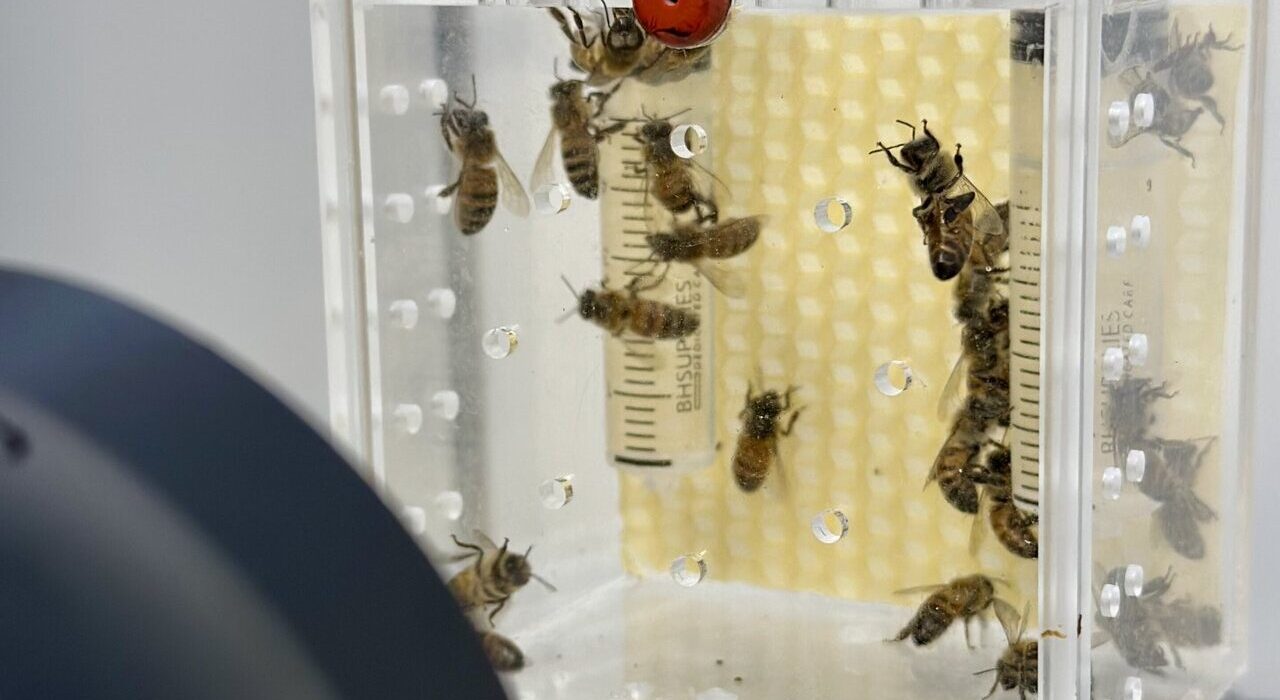As sleep experts advise humans to avoid screen time in bed due to the disruptive effects of blue light, scientists are discovering comparable impacts of artificial light on the natural world. The University of California San Diego (UCSD) discovered that artificial light at night (ALAN) alters honey bees’ circadian rhythms, jeopardizing their critical role in pollination and ecological stability.
The Influence of Honey Bees on Ecosystems and Food Security
Honeybees play an important role in pollinating wild flora and crops. These are essential for ecological balance and global food security. Without them, crops worth tens of millions of dollars would be at risk. While bees prefer to nest in dark, enclosed areas, their exposure to artificial light has grown as a result of urbanization and global warming.
With the rise of urban beekeeping, bees are more likely to meet artificial lights. Particularly, in warmer climates where bees may build exterior “bee beards” during hot evenings. This interaction with ALAN could have a wide-ranging impact on bee health and pollination efficiency.
Understanding Circadian Rhythms in Bees
Bees, like humans, rely on circadian rhythms to manage their sleep and waking cycles. These biological clocks are critical for overall health and functionality. Disrupted sleep patterns in bees cause behavioral difficulties that affect colony fitness. Bees, for example, convey food locations to their colony mates through a sophisticated “waggle dance.” Sleep-deprived bees conduct this dance poorly, limiting the colony’s capacity to locate resources efficiently.
The Effect of Artificial Light on Bee Behavior
In a new study published in Scientific Reports, researchers led by PhD candidate Ashley Kim and Professor James Nieh investigated how artificial light affects bee sleep and behavior. They conducted long-term trials comparing bees exposed to natural darkness versus those subjected to continuous artificial light.
The results were striking:
- Bees exposed to artificial light slept less and showed reduced behavior.
- Continuous light generated more disruptions among nestmates.
- Bees actively sought darker regions in their experimental enclosures, demonstrating their discomfort with prolonged light exposure.
“Even without analyzing the data, it was clear something was happening,” Kim told me. “The bees under constant light conditions were visibly sleeping less.”
Implications for Ecosystems
The artificial lighting reduction in sleep has major ramifications for pollination services, as well as food security and ecosystem health. Bees require sleep to function effectively as pollinators. When their communication and efficiency are disrupted, it can have a far-reaching environmental impact.
“Understanding the elements that affect bee health, such as light pollution, is essential for establishing tactics to protect pollinator populations,” Nieh told me. Light pollution already covers nearly 25% of the Earth’s surface, and its influence on biological systems requires immediate attention.
A Growing Area of Research
The work sheds light on the largely unexplored topic of how ALAN affects biological systems. Moreover, urbanization and climate change intensify these conditions, the findings highlight the importance of taking proactive actions to reduce light pollution’s effects on pollinators.
“The effects of light pollution on biological systems are fairly unknown and something people normally don’t think about. It is why it’s a rapidly evolving field,” Kim told Reuters.
Collaborative Research and Broader Impact
A diverse team of researchers worked on the project, including undergraduate students Aura Velazquez and Belen Saavedra from UCSD’s ENLACE program. This initiative encourages collaboration between Latin American and American students by providing hands- on research opportunities that address global issues such as pollinator health. Olivia Graeve, director of ENLACE, underlined the program’s value in bringing together varied perspectives to address urgent issues. “By fostering collaboration across borders, we help young researchers build skills and friendships while tackling challenges like environmental sustainability,” she told me.
Circadian Biology Research is Expanding
In a parallel project, Nieh and colleague Benjamin Smarr have won money from UCSD’s Catalyst Grant to investigate circadian rhythms across ecosystems and their relevance to human health. This interdisciplinary study brings together biology, data science, and medicine to investigate the synchronization of biological systems. And propose methods to mitigate the effects of light pollution.
“The Catalyst Grant strengthens UC San Diego’s role in pioneering solutions for both environmental sustainability and human well-being,” Nieh told me. “It connects our research on honey bee circadian rhythms to larger questions about biological synchronization.”
Protecting Pollinators for a Sustainable Future
This study emphasizes the importance of tackling light pollution to safeguard honey bee colonies and the natural settings they sustain. Bees’ health and functionality are intricately related to their surroundings, and even little disruptions, such as artificial light, can have far-reaching consequences for world food security and the environment.” By disrupting their circadian rhythms, we see clear evidence of reduced sleep periods,” according to Kim. “This raises significant concerns, not only for bee health but also for the health of ecosystems that depend on them for pollination.”
Final Thoughts
In conclusion, understanding the influence of artificial light on pollinators such as honeybees is critical. As it becomes more prevalent in both urban and rural areas. Mitigating light pollution can help conserve these vital organisms. The ecosystems they support and maintain a healthy and resilient environment for future generations.

